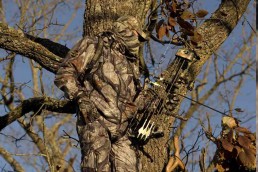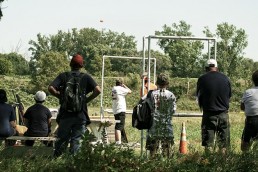SHARE THIS POST
If you’re like most hunting archers, you’ve already gotten in time at the location for 3-D shooting or in the backyard shooting with a buddy or two. You might even have had a deer-sized target that you have shot a few arrows at when you’ve had some more time on your hands. This is all good practice for shooting your bow or tuning it as well.
But are you really comfortable enough to do some serious deer hunting later this year after the practice you’ve done so far?
Many are well aware that deer rarely come into your shooting area from just the right direction and that there always seems to be some sort of problem in making the right shot. There are two ways you can go when this happens: pass on any possible shot and make a detailed note on how and where you can make changes to your setup for another shot, or incorporate those possible shots into your practice time now.
Let’s assume you’re hunting deer from a treestand. This is favored by many bowhunters, and you know you have to practice shooting from an elevated platform to replicate a shot while afield. You don’t have to set up a treestand in your backyard, although for some that is an option. Possibly, you can shoot off of a back porch to give you the practice of shooting from an elevated position. The key here is you’re practicing a type of shot and at an angle you’re anticipating could happen.
If you can set up your treestand and practice, you need to know if you can make a shot if a deer comes into your location from behind your setup or if it stands directly below you. There are a couple practice shots you can work with. First, you can lean out on a safety harness and make a shot around the tree your stand is set up in. Or, you can make a shot straight down on a deer at the base of your stand. If you can’t make either of these shots on a practice day, you’re going to have to pass on them in the fall. You are just going to have to wait for that deer to move to a position where you can make a clean shot.
Maybe you’re planning to hunt from a ground blind. To date, all of your practice has been while standing up in a normal shooting position. You have to have confidence in basically the same shot from a seated position. And if you plan on wearing gloves during the deer season, be sure to wear them now when you’re practicing, as they can and will affect the shot.
Are you enjoying this post?
You can be among the first to get the latest info on where to go, what to use and how to use it!
When practicing with normal bowhunting reps, you have to consider what sort of shot a deer might present and you have to be able to make that shot. Standing at a 20-yard line and shooting—as in indoor practice—is great for learning to handle your equipment, but doesn’t necessarily translate to actual live hunting shots. And while making your practice shooting even a bit more realistic, again, don’t forget to wear the accessories and clothes you intend to have on later. If you wear a facemask, put it on during your practice once in a while to make sure it doesn’t negatively affect your anchor or you may end up having to modify it during the season.
If you intend to wear anything around your neck like field glasses or a range finder, put these on during practice now to ensure there are no future problems. That goes for your quiver as well. If you have a bow quiver and intend to hunt with it on, practice with it in place now and see how your accuracy is affected.
Then there is the biggest problem facing you: distance of a shot. You can learn now in the summer just how far you can shoot and make a lethal kill. Learn this distance now so that when you’re afield in fall and are tempted to try a shot you know is beyond your ability to make a clean kill, you’ll then be able to recognize it easier when you have to pass on the shot.
For practicing shots, you can make a game out of it. I use to play a game with hunting buddies where we would set up our shooting blocks in a lightly wooded area. The ones that you can shoot all four sides work great for this practice. The first shooter picks a shot at one of the targets while the others must try to better the shot. Each time, the person with a winning shot then calls the next shot, and at any chosen target and position. This practice game will greatly enhance your ability to figure the distance of a shot as well as make a shot from difficult positions.
Remember, making your practice time as close to the real thing now can pay off for you while afield during the season.
MWO
SHARE THIS POST
Did you enjoy this post?
You can be among the first to get the latest info on where to go, what to use and how to use it!
Bob Gorge
Bob Gorge is an avid bowhunter, with many big game animals to his credit. He has been an official big game scorer. He’s also a long-time archery instructor, working with several different organizations. As an instructor, he runs the gamut, working with everyone from seasoned bowhunters to beginning children.



